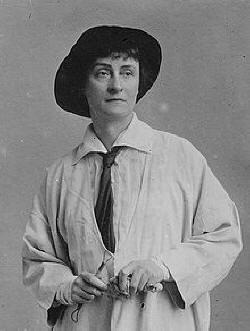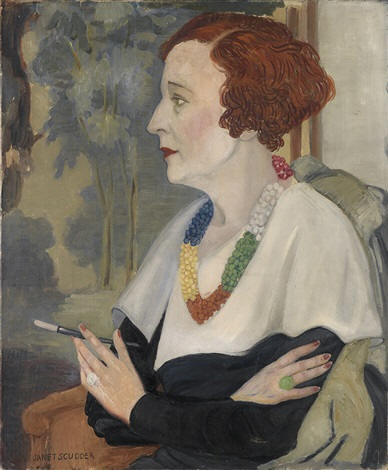

Queer Places:
Art Academy of Cincinnati, 1212 Jackson St, Cincinnati, OH 45202, Stati Uniti
Académie Colarossi, 10 Rue de la Grande Chaumière, 75006 Paris, Francia
173 S Oxford St, Brooklyn, NY 11217, Stati Uniti
 Janet
Scudder (October 27, 1869 – June 9, 1940) was an American sculptor and painter.
Janet
Scudder (October 27, 1869 – June 9, 1940) was an American sculptor and painter.
Born Netta Deweze Frazee in Terre Haute, Indiana, Scudder had a childhood marred by tragedy.[1] Her father, William Hollingshead Scudder, was a confectioner who was active in community affairs. Her mother, Mary Sparks, died at 38 and four of her seven siblings died before they reached adulthood. Scudder was raised by Hannah Hussey, the family maid, cook and nurse, with whom she did not get along.[2]
As a child Scudder studied drawing under Professor William Ames of Rose Polytechnic Institute of Technology, now Rose-Hulman Institute of Technology.[2] Despite his fragile financial resources, her father enrolled her in the Cincinnati Art Academy so she could study sculpture with Louis Rebisso.[1] She focused on woodcarving and adopted the given name "Janet".[2] Her father, William Scudder, died September 15, 1888, while his precocious daughter was teaching woodcarving at Coates College for Women in Terre Haute.
Scudder moved to Chicago in 1891, and was briefly employed as a wood carver in a furniture factory – a job she ultimately lost because the union did not permit women members. She found work with the sculptor Lorado Taft as an assistant, making $5 a day working on monumental sculptures for the Chicago World's Fair.[3] She was one of a group of women sculptors and assistants nicknamed the White Rabbits.[1] Scudder was also commissioned to create a figure of Justice for the Illinois state building and a sculpture of a nymph for Indiana.[4]
After seeing Frederick W. MacMonnies' fountain "the Barge of State" at the World's Fair, she decided to go to Paris and work for him. She was the first woman to be employed at his atelier.[1] While in Paris Scudder also studied at the Académie Vitti and at the Académie Colarossi.[5][6]

Portrait of a Woman (Peggy Guggenheim), by
Janet Scudder
Metropolitan Museum of Art, NYC
In 1896, after two years in Paris, Scudder returned to America and tried and failed to find work as a sculptor. Eventually, through the intercession of another artist, she received a commission to model the seal for the New York Bar Association. From that point on she had steady work sculpting portrait medalions, architectural ornament, and funerary urns.[4]
In 1898 Scudder returned to Paris, then spent a year traveling through Italy where she found fresh inspiration in the cherubic figures of Donatello and Verrocchio.[6] She began making amusing sculptures and fountains featuring lively children, her "water babies." With works like Frog Fountain, Scudder became one of the most prolific and successful makers of garden sculptures.[1] She was frequently commissioned to make them for the homes of wealthy Americans like John D. Rockefeller and Henry Huntington.[4]
In Paris Scudder's social circle grew to include Gertrude Stein, Alice B. Toklas, Mildred Aldrich, and Eve Mudocci.[7] Malvina Hoffman worked as her studio assistant.[8] Scudder was a feminist and suffragette who frequently marched in parades and demonstrations involved with women's issues. She opposed having separate exhibitions for male and female artists and disliked being described as a woman artist.[9] She was a member of the art committee of the National American Women Suffrage Association.[4]
Scudder was elected an associate of the National Academy of Design in 1920, and was named a Chevalier of the French Legion of Honor for her relief work during World War I. She published an autobiography, Modeling My Life, in 1925.[4] A portrait of Scudder in the National Academy of Design collection was painted by Margaret Bucknell Pecorini.[10]
Janet Flanner's review of the 1932 American Women’s Show reminded that a number of talented American artists were then active: “The work of Lillian Cotton, Gwen Le Gallienne, Janet Scudder, Ivy Troutman, and Lillian Fisk, among others, showed an amazonian quality of strength that did not surprise or fail to please. As a group, theirs was by all odds the best amalgamated work of the year”. This same letter included an assessment of work by Salvador Dali, Jean Cocteau (ink drawings), and Francis Rose, the newly discovered protégé of Gertrude Stein.
Scudder lived in Paris until 1939, when she returned to New York to reside with her companion, author Marion Benedict Cothren. She died of pneumonia on June 9, 1940 in Rockport, Massachusetts.[3]
My published books: